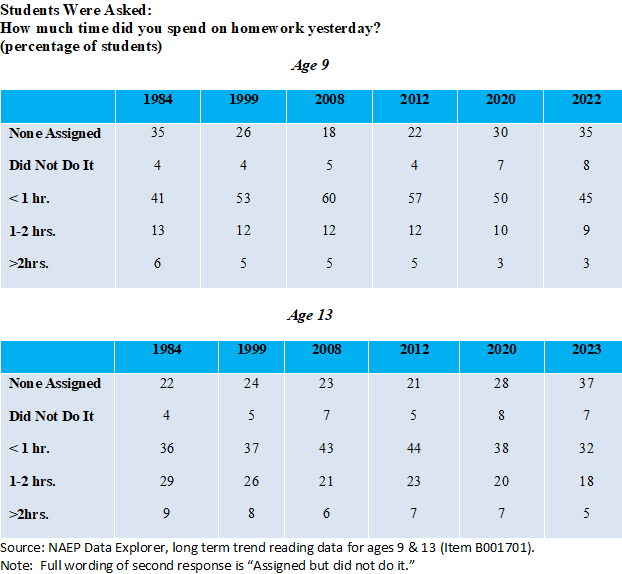In August, 2022, I published a blog post about homework. Anticipating the long term trend (LTT) NAEP data that were about to be released, I pointed out that homework had been in decline for nine- and thirteen-year olds during the pre-pandemic years. I wondered whether the trend would continue. The data are now in, and it is time to post an update.
In short, yes, homework continued to decline. Like so many trends in education that began before covid--public school enrollment losses, stagnant test scores, reports of disruptive students, chronic absenteeism--the pandemic seemed to magnify, but not initiate, trends that had started earlier.
In the tables below, the data are from LTT NAEP student surveys, administered to nine- and thirteen-year-olds. The first two rows show the percentage of students reporting no homework at all, either because none was assigned or it was assigned but students didn't do it. At age 9 in 2022, 43% of students (modal grade is fourth) fall into that category, the largest share since the question was first asked nearly four decades ago. In 2008, it was only 23%.
A similar pattern is true for thirteen-year-olds (modal grade is eighth). The 44% with no homework in 2023 eclipses all other time periods in the table. The low point of 26% was registered in 1984 and again in 2012.
Examining the percentage of students with a heavy amount of homework, more than two hours, underscores the general trend: only 3% of students at age 9 (in both 2020 and 2022) and 5% at age 13 (in 2023). Few students have ever faced two hours per day of homework, despite anti-homework hysteria that broke out in the late 1990s and extended into the early 2000's. Major U.S. magazine covers featured stressed-out kids burried under hours of nightly homework. A 1999 TIME cover shouted "Too Much Homework!"

Sociologists of education have long been concerned with the tensions inherent to adults placing demands on students. In the 1930s, Willard Waller characterized the school as a "despotic organization," necessairly so as universal schooling took hold and the Great Depression forced reluctant youths into classrooms. James Coleman described a decidedly anti-scholastic"adoloscent society" that dominated high schools in the 1950s, awarding social status on the basis of attractive appearance or accomplishments in sports, not scholarship. Coleman did not blame teenagers or rely on "kids will be kids" as a facile explanation, instead, arguing that teens were acting rationally within a social structure built and maintained by adults.
Two quick thoughts. The data above focus on an empirical question: how much homework do kids have? That's different from the normative question: how much homework should kids have? It's the normative question that draws the most attention on social media, but it's difficult to imagine a satisfactory answer that does not include an estimate of the current homework load. Secondly, adults, primarily teachers and parents, are in charge when it comes to deciding the amount of homework that is appropriate. Coming out of the pandemic, decisions adults make regarding what is expected of children will largely determine, not only for homework but also for attendance, achievement, behavior and some of the other troubling trends in place, whether improvement or further deterioration lies ahead.